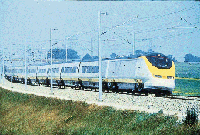Radars are used for navigation, weather forecasting, and military applications, as well as a variety of other functions. They emit pulsed microwave signals. The peak power in the pulse can be high even though the average power may be low. Many radars rotate or move up and down; this reduces the mean power density to which the public is exposed in the vicinity of radars. Even high power, non-rotating military radars limit exposures to below guideline levels at locations of public access.
Security systems
Anti-theft systems in shops use tags that are detected by electrical coils at the exits. When a purchase is made the tags are removed or permanently deactivated. The electromagnetic fields from the coils do not generally exceed exposure guideline levels. Access control systems work in the same way with the tag incorporated into a key ring or identity card. Library security systems use tags that can be deactivated when a book is borrowed and reactivated when it is returned. Metal detectors and airport security systems set up a strong magnetic field of up to 100 μT that is disturbed by the presence of a metal object. Close to the frame of the detector, magnetic field strengths may approach and occasionally exceed guideline levels. However, this does not constitute a health hazard, as will be discussed in the section on guidelines. (see Are exposures above the guidelines harmful?)

Electric trains and trams
Long-distance trains have one or more engine cars that are separate from the passenger cars. Thus passenger exposure comes mainly from the electricity supply to the train. Magnetic fields in the passenger cars of long-distance trains can be several hundred μT near the floor, with lower values (tens of μT) elsewhere in the compartment. Electric field strengths may reach 300 V/m. People living in the vicinity of railway lines may encounter magnetic fields from the overhead supply which, depending on the country, may be comparable to the fields produced by high-voltage power lines.

Motors and traction equipment of trains and trams are normally located underneath the floors of passenger cars. At floor level, magnetic field intensities may amount to tens of μT in regions of the floor just above the motor. The fields fall off quickly with distance from the floor, and exposure of the upper bodies of passengers is much lower.
TV and radio
When choosing a radio station on your stereo at home, have you ever wondered what the familiar abbreviations AM and FM stand for? Radio signals are described as amplitude-modulated (AM) or frequency-modulated (FM) depending on the way in which they carry information. AM radio signals can be used for broadcasting over very long distances whereas FM waves cover more localized areas but can give a better sound quality.AM radio signals are transmitted via large arrays of antennas, which can be tens of metres high, on sites which are off-limits to the public. Exposures very close to antennas and feed cables can be high, but these would affect maintenance workers rather than the general public.
TV and FM radioantennas are much smaller than AM radio antennas and are mounted in arrays at the top of high towers. The towers themselves serve only as supporting structures. As exposures near the foot of these towe
- 2023 Chinese Electromagnetic Shielding Protective Clothing (radiation suit radiation maternity dress) Physical Store Quality Sampling Assessment(05/02/2023)
Recently, for the suit of electromagnetic radiation of Chinese mainland (known locally as radiation suits, or radiation maternity), ESMMC conducted a field shop unannounced visits, sampling activities. ESMMC sampled the product storage, and entrusted with maintaining long-term relationships globally recognized laboratories for product quality assessment. This is results of the evaluation.
- Chinese domestic civil electromagnetic radiation protective clothing brands comprehensive evaluation(06/02/2020)
Evaluation results are translated into scores (PETS), each critical point to 20pets out, the following are survey results, press out successively in the order presented
- 2019 Report on Functional Comparison Test of Radiation-proof Clothes for Pregnant Women(27/02/2019)
he rise of technology allows us to enjoy unexpected life experience. However, electromagnetic radiation brought by various electronic and electrical products has become a new concern. According to the ESMMC survey, more than 90% of women will purchase radiation-proof clothes when preparing themselves for pregnancy in response to the increasingly complex environment exposed to electromagnetic radiation.
- Scientific Radiation Protection, Care for the Future, ESMMC Comparative Test Report on Radiation Protection Maternity Wear and Top Ten Radiation Protection Wear(01/08/2018)
Radiation protection maternity wear of unique materials and reasonable design can adapt to physiological changes of pregnant women and shield them from radiation, thus gaining great attention among pregnant women. Brands of radiation protection clothing such as U+ (Youjia) and JOYNCLEON have become the hot topic of conversations among expectant mothers.
- Questionnaire survey on the consumers' experience of radiation maternity dress in 2016(18/03/2016)
The questionnaire aims to the pregnant women in 71 hospitals from Beijing, Shanghai, Guangzhou and other cities. A total of 6000 questionnaires were distributed including 3652 questionnaires acquired and 3541 effective questionnaire
- ESMMC announce:Asia Pacific Civil electromagnetic shielding clothing sampling assessment( 2014)(08/01/2015)
- ESMMC: Spin Transport and Magnetization Dynamics in Metals-Based Systems(10/02/2014)
Spin-related effects in metals and in ferromagnetic heterostructures are generally robust and observable at room temperature.
- ESMMC: Magnetic Nanostructures: Materials and Phenomena(26/01/2014)
Reduced dimensionality, confinement, and reduced scale often lead to magnetic structures and spin behavior that is markedly different from that of the bulk.
- WHO:《the health risks associated with mobile phones and their base stations》(14/01/2014)
the health risks associated with mobile phones and their base stations
- ESMMC 2014 Annual Meeting will be Held in Paris, FR(02/01/2014)
The 2014 Annual Meeting of the Electromagnetic Shielding Technical Steering Committee (ESMMC) will be held in Paris FR, bringing together experts across a wide range of fields to present new developments in electrostatics shield.
©ESMMC 2013 ESMMC including ESMMC Asia,ESMMC Europe,ESMMC America,ESMMC Africa,ESMMC Oceania.
